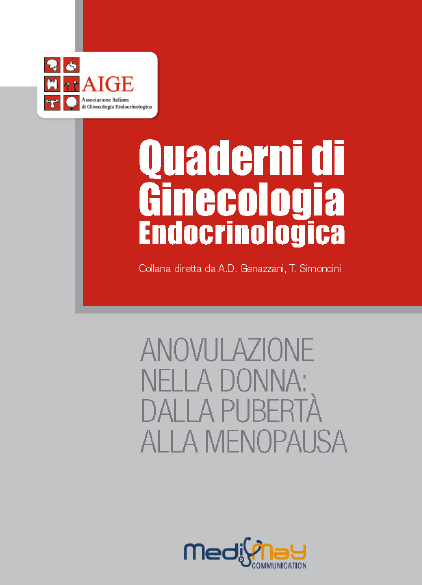-
Alessandro D. Genazzani, Alessia Prati, Tommaso Simoncini, Antonella Napolitano
Modulatory role of D-chiro-inositol and alpha lipoic acid combination on hormonal and metabolic parameters of overweight/obese PCOS patients
European Gynecology and Obstetrics. 2019; 1(1):29-33
Download
Abstract
Polycystic ovary syndrome (PCOS) is a frequent disease characterized by several endocrine impairments and frequent metabolic abnormality, i.e. compensatory hyperinsulinemia.|| Aims: To evaluate the improvements induced by a daily treatment with a combination of d-chiro-inositol (DCI) (500 mg) and alpha-lipoic acid (ALA) (300 mg) for 12 weeks. || Setting: retrospective study || Design: Thirty overweight/obese patients were evaluated. The presence/absence of first-degree diabetic relatives was ascertained. Patients were administered DCI (500mg/day) and ALA (300 mg/day) per os for at least 12 weeks. Only patients completing 12 weeks of treatment (n=30) were included in the study. Patients were evaluated before and after the treatment through measurement of plasma levels of LH (Luteinizing Hormone), FSH (Follicle Stimulating Hormone), estradiol, progesterone, androstenedione, testosterone, insulin, glutamic oxaloacetic transaminase (GOT), and glutamic pyruvic transaminase (GPT). They also underwent an oral glucose tolerance test (OGTT) to evaluate glucose, insulin and c-peptide responses. || Results: The combination treatment improved hormonal and metabolic parameters, as well as insulin and c-peptide responses to OGTT and the HOMA index. On subdividing the patients by presence/absence of familial diabetes, DCI+ALA was found to be more effective, both on metabolic and on hormonal parameters, in PCOS subjects with familial diabetes. PCOS patients with familial diabetes had higher baseline GOT and GPT levels than those with no familial diabetes and the combination treatment significantly reduced these levels. Conclusions DCI+ALA proved to be an efficient combination that improved insulin sensitivity and hormonal and metabolic profiles in overweight/obese PCOS patients, especially those with familial diabetes, in whom it reduced the GOT and GPT levels. This latter effect might reduce the risk of non-alcoholic fatty liver disease (NAFLD), typical of PCOS patients.
-
Diana Jędrzejuk, Andrzej Milewicz, Ewa Bar-Andziak, Tomasz Miazgowski
What is the relationship between visceral adiposity index (VAI) and total and free sex hormones in aging polish women?European Gynecology and Obstetrics. 2019; 1(1):48-50
Download
Abstract
The visceral adiposity index (VAI) is a novel and very sensitive cardiometabolic predictor. The number of cardiovascular diseases in women increases with climacteric transformation. In 505 women aged over 65 years, randomly selected from the whole of Poland, we investigated whether VAI score was associated with sex hormones. We split the women into two groups on the basis of a VAI cut-off score of 2.0. In the group with normal VAI scores, we found significantly higher serum testosterone levels and a lower free estradiol index vs the group with abnormal VAI scores. VAI correlated positively with fasting glucose and insulin levels and with homeostatic model assessment of insulin resistance (HOMA-IR). Our data suggest a cardiometabolic protective role of testosterone in aging women.
-
Szeliga, A., Podfigurna, A., Bala, G. , Meczekalski B.
Kisspeptin and neurokinin B analogs use in gynecological endocrinology: where do we stand?
J Endocrinol Invest (2019) doi:10.1007/s40618-019-01160-0
Background – Recent studies have found that kisspeptin/neurokinin B/dynorphin neurons (KNDy neurons) in the infundibular nucleus play a crucial role in the reproductive axis. Analogs, both agonists and antagonists, of kisspeptin and neurokinin B (NKB) are particularly important in explaining the physiological role of KNDy in the reproductive axis in animals. The use of kisspeptin and NKB analogs has helped elucidate the regulators of the hypothalamic reproductive axis.
Purpose – This review describes therapeutic uses of Kiss-1 and NKB agonists, most obviously the use of kisspeptin agonists in the treatment for infertility and the induction of ovulation. Kisspeptin antagonists may have potential clinical applications in patients suffering from diseases associated with enhanced LH pulse frequency, such as polycystic ovary syndrome or menopause. The inhibition of pubertal development using Kiss antagonists may be used as a therapeutic option in precocious puberty. Kisspeptin antagonists have been found capable of inhibiting ovulation and have been proposed as novel contraceptives. Hypothalamic amenorrhea and delayed puberty are conditions in which normalization of LH secretion may potentially be achieved by treatment with both kisspeptin and NKB agonists. NKB antagonists are used to treat vasomotor symptoms in postmenopausal women, providing rapid relief of symptoms while supplanting the need for exogenous estrogen exposure.
Conclusions – There is a wide spectrum of therapeutic uses of Kiss-1 and NKB agonists, including the management of infertility, treatment for PCOS, functional hypothalamic amenorrhea or postmenopausal vasomotor symptoms, as well as contraceptive issues. Nevertheless, further research is needed before kisspeptin and NKB analogs are fully incorporated in clinical practice
-
Antonino Di Pino and Ralph A. DeFronzo
Insulin Resistance and Atherosclerosis: Implications for Insulin-Sensitizing Agents
Endocrine Reviews 40: 1447 – 1467, 2019
Patients with type 2 diabetes mellitus (T2DM) are at high risk for macrovascular complications, which represent the major cause of mortality. Despite effective treatment of established cardiovascular (CV) risk factors (dyslipidemia, hypertension, procoagulant state), there remains a significant amount of unexplained CV risk. Insulin resistance is associated with a cluster of cardiometabolic risk factors known collectively as the insulin resistance (metabolic) syndrome (IRS). Considerable evidence, reviewed herein, suggests that insulin resistance and the IRS contribute to this unexplained CV risk in patients with T2DM. Accordingly, CV outcome trials with pioglitazone have demonstrated that this insulin-sensitizing thiazolidinedione reduces CV events in high-risk patients with T2DM. In this review the roles of insulin resistance and the IRS in the development of atherosclerotic CV disease and the impact of the insulin-sensitizing agents and of other antihyperglycemic medications on CV outcomes are discussed.
-
Karolien Van De Maele, Jean De Schepper, Jesse Vanbesien, Monique Van Helvoirt, Ann De Guchtenaere, Inge Gies
Is vitamin D deficiency in obese youth a risk factor for less weight loss during a weight loss program?
Endocrine Connections (2019) 8, 1468–1473
Download
Background: Vitamin D deficiency is common in obese adolescents and a risk factor for insulin resistance. We investigated if prevailing serum 25-OH vitamin D might predict the body fat loss in a group of obese adolescents undergoing a resi dential weight loss program.
Methods: In 92 (35 male) obese adolescents (aged 10.6–19 years) undergoing a residential weight loss program in Belgium, fasting serum 25-OH vitamin D ( 25-OH-D), insulin, glucose and lipid levels were measured and body composition was assessed by dual-energy X-ray absorptiometry (DXA).
Results: Baseline median (range) serum 25-OH-D level was 17.7 μg/L (3.8 –41.8). In total, 55 adolescents had a serum 25-OH-D below 20 μg/L. In 31 adolesc ents with a low baseline 25-OH-D level, median increase in serum 25-OH-D was 2. 4 μg/L (−4.2 to 7.2) after 10 months. This resulted in normal 25-OH-D levels in seve n adolescents, whereas median BMI decreased with 1.0 SDS and body fat percentage dimin ished with 9.9%. Obese adolescents with or without a 25-OH-D level below or abov e 20 μg/L at baseline had similar changes in body weight, BMI SDS, body fat percentag e and body fat mass at the end of the program. The change in serum 25-OH-D did not cor relate with change in serum insulin, BMI SDS or body fat percentage and body fat mass .
Conclusion: Vitamin D deficiency was present in 55 out of 92 obese adolesce nts at the start of the summer. Serum 25-OH-D concentration did not predict chan ges in body fat loss after a residential weight loss program
-
Sunyoung Kang , Min Hyoung Kim , Moon Young Kim , Joon-Seok Hong , Soo Heon Kwak, Sung Hee Choi, Soo Lim, Kyong Soo Park, Hak C. Jang
Progression to Gestational Diabetes Mellitus in Pregnant Women with One Abnormal Value in Repeated Oral Glucose Tolerance Tests
Diabetes Metab J 2019;43:607-614
Download
Background: Women with one abnormal value (OAV) in a 100 g oral glucose tolerance test (OGTT) during pregnancy are reported to have an increased risk of adverse pregnancy outcomes. However, there is limited data about whether women with OAV will progress to gestational diabetes mellitus (GDM) when the OGTT is repeated.
Methods: To identify clinical and metabolic predictors for GDM in women with OAV, we conducted a retrospective study and identified women with OAV in the OGTT done at 24 to 30 weeks gestational age (GA) and repeated the second OGTT between 32 and 34 weeks of GA
Results: Among 137 women with OAV in the initial OGTT, 58 (42.3%) had normal, 40 (29.2%) had OAV and 39 (28.5%) had GDM in the second OGTT. Maternal age, prepregnancy body mass index, weight gain from prepregnancy to the second OGTT, GA at the time of the OGTT, and parity were similar among normal, OAV, and GDM groups. Plasma glucose levels in screening tests were different (151.8±15.7, 155.8±14.6, 162.5±20.3 mg/dL, P<0.05), but fasting, 1-, 2-, and 3-hour glucose levels in the initial OGTT were not. Compared to women with screen negative, women with untreated OAV had a higher frequency of macrosomia.
Conclusion: We demonstrated that women with OAV in the initial OGTT significantly progressed to GDM in the second OGTT. Clinical parameters predicting progression to GDM were not found. Repeating the OGTT in women with OAV in the initial test may be helpful to detect GDM progression.






